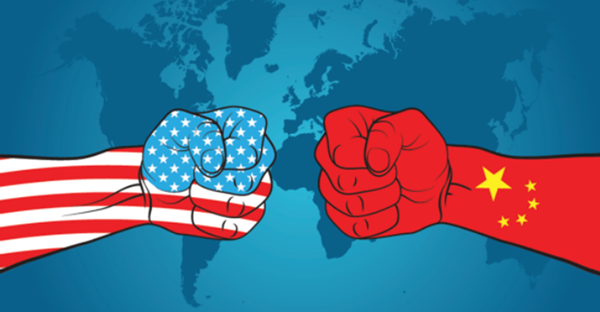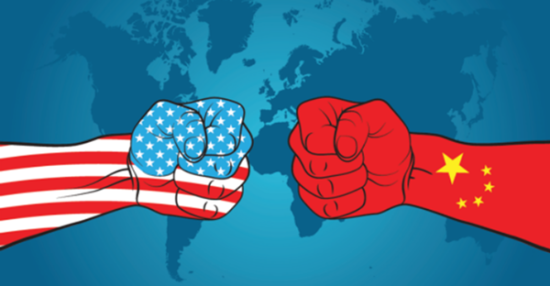Escalation of tit-for-tat conflict between world’s largest economies
By Vincent Kolo
The trade conflict between China and the US has escalated in recent weeks. Beijing initially believed it could ‘manage’ relations with the unstable US administration and its petulant leader to avert a trade war through negotiations and by offering some concessions. This is still possible. But Chinese leaders have become dismayed and perhaps to some extent also thrown off balance by the hardening positions of Trump’s government.
This has even thrown into question the May visit of vice-premier Liu He to Washington for the next round of trade negotiations. The Chinese side are frustrated that Liu’s trip may again prove fruitless. In February, the Trump administration announced steel and aluminium tariffs against several countries including China on the same day Liu was in Washington meeting with US trade officials.
At this stage the conflict is still mainly at the stage of threats and counter-threats. Even Trump’s steel tariffs haven’t yet taken effect. In April, Washington raised the stakes with a threat to impose punitive tariffs against US$50 billion of Chinese industrial goods alleging theft of US technology and intellectual property (copyrights). These measures will not be implemented until a review procedure in the US government has been completed. China responded by announcing a provisional package of countermeasures worth US$50 billion. Trump then threatened tariffs on a further US$100 billion worth of Chinese goods.

Power struggle
Globally, the capitalists have grown increasingly nervous that this ‘chicken race’ of escalating threats, ostensibly to push the other side into making a deal, may get out of control. But deep down this is not only a trade conflict, it is a more fundamental geopolitical and economic power struggle between the two giants.
Trump’s administration represents a wing of US capitalism that believes now is the time to decisively push back against China’s increasing challenge to US power. Alongside the infected trade issues are potentially bigger conflicts: Taiwan, control of the South China Sea, and even the upcoming Trump-Kim summit on North Korea’s nuclear programme – a detente that has evidently unsettled Beijing.
Within the wider trade imbroglio there is a rapidly escalating “tech war”, with Trump’s administration and significant sections of US capitalism, especially the military, determined to thwart China’s ‘Made in China 2025’ plan to establish Chinese pre-eminence in crucial technologies such as robotics, electric vehicles, advanced information technology and aviation. As the conflict unfolds it is becoming clear that ‘Made in China 2025’ – or rather blocking it – is the core issue for the US government.
➵ World economy: Close to a trade war?
One early casualty is the Chinese telecom giant ZTE, which has been slapped with a seven-year ban on buying US technology components and software, in a case that involves alleged sanctions busting in Iran. Shenzhen-based ZTE, the fourth-largest smartphone company in the US market, is now in deep crisis with its 75,000 workforce facing an uncertain future. More than a third of its components are sourced from US companies and even the Android platforms used in its phones may fall under the terms of the US ban. ZTE’s crisis, and possible collapse, is not just a Chinese problem but is already rippling through the global telecom sector with many national telecom providers building their services around ZTE’s products.
Wall Street pressure
Beijing’s trade strategy has been a combination of carrot and stick, its approach to almost all problems. It has matched Trump’s team, threat for threat, while at the same time launching a package of proposals for increased ‘market reforms’ and concessions to foreign capitalism.
Beijing’s calculation, right or wrong, is that Wall Street and the big guns of US capitalism will exert pressure on the trade hawks in Trump’s government to reach a deal before major damage is done. That such pressure is building is already apparent. However, while the Chinese regime has long been able to rely on its considerable pull especially within US financial circles as a counterweight to US government demands, this method is not as effective as it once was.
There are increasing fears that the hardening of positions could develop its own logic, jeopardising the chances of reaching a deal. Both Trump and Xi rely heavily on nationalist rhetoric as a pillar of their rule: “Make (insert country here) Great Again!”
Both governments are under mounting pressure at home. Xi’s regime is less ‘stable’ than it wants the world to think. Workers’ strikes are increasing, running at double the level of a year ago in the first three months of 2018, and increasingly less isolated as workers’ coordinating abilities and consciousness have grown. Recent political missteps such as Xi’s ‘emperor’ gambit and a short-lived attempt to ban gay content on Weibo, China’s version of Twitter, have triggered unprecedented online protests.
➵ Trump and China: Heading for conflict?
While Xi’s team are likely to agree an increased tempo of pro-market ‘reforms’ in designated sectors – to head off protectionist pressures – the main economic trend in China will be an even greater resort to state capitalist measures. This is especially likely in the event of a full-scale US-China tech war, which would force Beijing to plough massive new investments into developing homegrown technologies in areas such as semiconductors where it is heavily dependent on foreign imports.
Beijing has already identified a range of economic concessions to be thrown into negotiations with the US, some of which were announced already last year (such as plans to allow greater access to China’s finance and insurance sectors for US companies, including majority-ownership). It has also promised to buy more US goods in order to reduce the US trade deficit. The Chinese regime believes many of these concessions – some real and others largely cosmetic – will actually assist it to upgrade and strengthen its state capitalist economic model without surrendering real economic control.
But Xi’s readiness to make concessions has limits and he cannot allow himself to be perceived as a loser – a weak leader. The Chinese regime has studied and has no intention of following the example of Japan, bullied in 1985 (‘Plaza Accords’) into revaluing its currency as a concession to US capitalism.
“Humiliating demands”
Indeed, the latest “draft framework” from Trump’s trade negotiators makes “humiliating demands” on China, according to Martin Wolf in the Financial Times (8 May 2018). The US side is demanding China cut its US$375 billion trade surplus with the US by US$200 billion dollars in the next two years. This is a doubling of Trump’s previous demand for a US$100 billion reduction. Furthermore the US demands China surrender its rights to “oppose, challenge, or… retaliate” (!) if the US imposes bans on Chinese investments in the US technology sector.
It is as if the US trade team, dominated by anti-China ideologues such as Peter Navarro and Robert Lighthizer, has deliberately framed its demands to produce a breakdown in negotiations. Such conditions, “would be a modern version of the ‘unequal treaties’ of the 19th century,” says Martin Wolf who also warns, “This may be a decisive moment for relations between the world’s two greatest powers”.
For socialists these developments are not a surprise, notwithstanding the staggering speed at which they unfold. The unprecedented capitalist crisis which began a decade ago has set the stage for sharpening imperialist tensions. Socialists stress the need for the workers’ movement to act independently and not be dragooned into supporting one national capitalist gang against another. The socialist alternative is economic planning and trade under a system of working class democracy to replace capitalist misrule.




